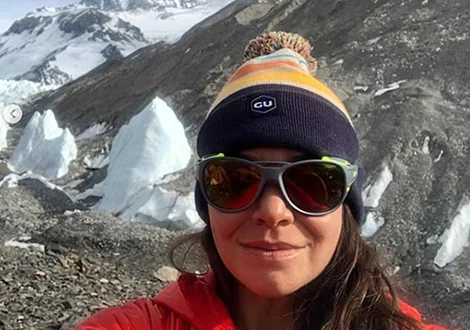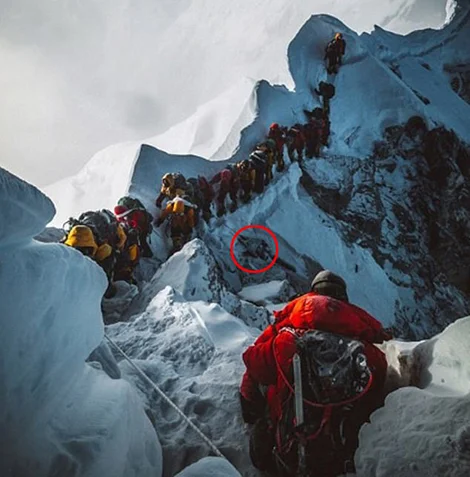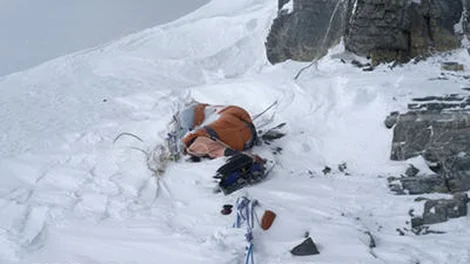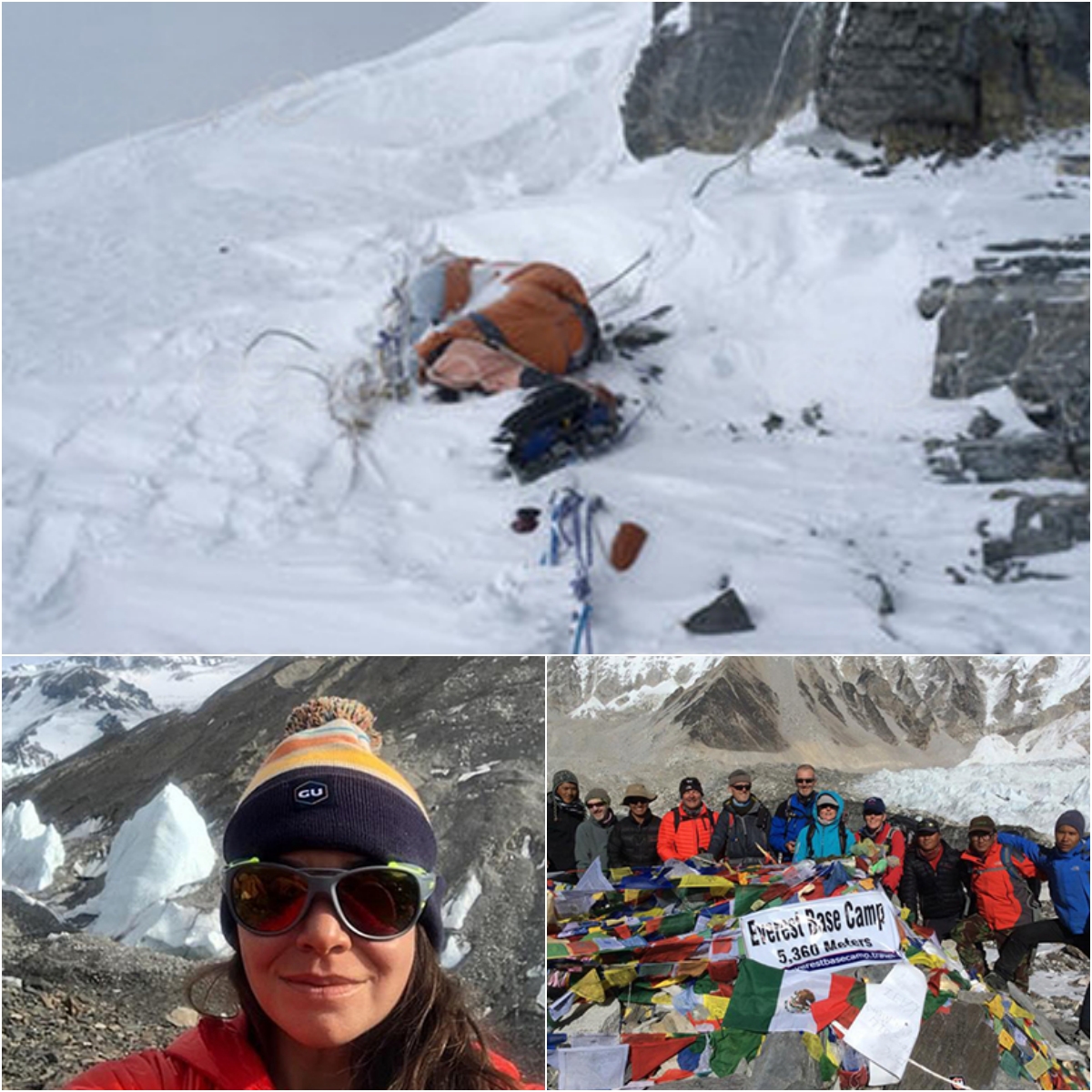As a world-class female mountaineer, Roxanne Vogel, 33, from Berkeley, California, witnessed the deaths of 6 out of 11 people who perished between May 18 and 25, 2019. They were part of a group of 150 climbers “queuing” to reach the summit of Mount Everest. Most of the deaths were due to cerebral and pulmonary edema, consequences of acute altitude sickness. According to Vogel, the main cause of this tragedy was the commercialization of the sport by the Nepal Tourism Board.

Roxanne Vogel before departing from the Tibet side.
1. The Deadly Climbing Season
Unlike Edmund Hillary and Tenzing Norgay, who in 1953 chose the Nepalese side to conquer the 8,848m “roof of the world,” Roxanne Vogel chose the Tibetan side in China for her ascent. “Due to the extremely harsh terrain on the Tibetan side of Everest, 90% of climbers now follow the route taken by Hillary and Norgay,” Vogel said. “Only the remaining 10% choose Tibet, including me.”
Vogel, who works as a quality assurance manager for GU Labs, a company specializing in sports nutrition, began her climb on May 11, 2019, and reached the summit two weeks later. She explained the difference between the two routes: “If you take the Nepalese route, the first thing you do is go to Base Camp at 5,360m. Then, you ascend to Camps I, II, III, and IV at heights of 6,035m, 6,474m, 7,158m, and 7,096m respectively. After that, you reach a small, rocky area shaped like a saddle, called the ‘Hillary Step’—where Hillary and Norgay rested before climbing the final 30m.”

Climbers at Base Camp before ascending Mount Everest.
Vogel’s Tibetan route was equally challenging. She ascended the Rongbuk Glacier, also known as Base Camp, at 5,180m. To reach Camp II (Changtse) at 6,100m, she followed the glacier’s eastern side. The path from Camp II to Camp III (ABC) was a series of vertical rock faces, while the journey from Camp III to Camp IV (North Col) at 7,101m was nicknamed the “death zone” by climbers. “On this section, Sherpa guides hammered steel stakes deep into the ice and strung ropes because from 7,000m upwards, there are constant blizzards and strong winds,” Vogel said. “Temperatures range from -15 to -30 degrees Celsius in the summer.”
From Camp IV, Vogel continued to Camp V at 7,775m, and then to Camp VI at 8,320m, where the path was a treacherous series of jagged rock faces. At this point, she navigated three final rock steps, known as Step 1, Step 2, and Step 3, before reaching a 60-degree slope that led to the summit. It was on this summit that she saw the deaths of six climbers. “Nine of the 11 victims died at altitudes above 8,000m, where the oxygen level in the air is only 30% of normal,” she recalled.
2. The Avalanche of Tragedy

The body of a mountaineer (in the circle) while nearly 150 other people are trying to ascend or descend on a single path.
Every year from late April to late May, countless climbers flock to Nepal with the dream of conquering Mount Everest. According to Nepal’s Tourism Board statistics, only about 30% of climbers successfully reach the summit annually. The 70% who fail often suffer from intolerance to air pressure, poor health, and insufficient oxygen reserves due to delays caused by blizzards. This year, the board issued a record 381 climbing permits, a significant increase from 207 the previous year. The cost of a permit is $11,000, not including expenses for gear, food, and guides.
Vogel recounts the scene at the top: “Standing on Everest, I saw a long line of people snaking up the mountain. Because the summit is only the size of two ping-pong tables, a maximum of 15 people are allowed up at a time, and they can only stay for 15 minutes for photos.” The remaining climbers had to wait for an average of one hour for their turn.
One hour at an altitude of nearly 8,800m, where temperatures hover between -19 and -30 degrees Celsius, proved to be a death trap. “Right on the summit, I saw four bodies. They were just a few steps away from me, so I had to stop. I didn’t know what to do because the dead are often left there until rescue teams can bring them down, which can take years depending on the weather,” Vogel said.
Dr. Dohring, a fellow climber from Arizona, also described a tragic incident: “A young man came down from the summit, following the rope the Sherpas had set up. As he passed me, I saw his face was a ghostly gray. I later learned his name was Robin Haynes Fisher, a British man. About 150m down, Fisher suddenly collapsed. A Sherpa tried to help him and checked his oxygen tank, but he was already dead.” A week before his death, Fisher had warned on Instagram about the dangers of overcrowding: “There is only one path to the summit, and delays due to the crowd can be fatal.”
The next victim was Irishman Kevin Hynes, 56, who had turned back and set up a tent at 7,500m. He died in his sleep. Later that afternoon, Sherpa guide Dhurba Bista, 33, died while bringing Indian climber Nihal Bagwan back to Base Camp, but Bagwan also didn’t survive.

The body of a climber at an altitude of 8,640m. It could take several years for rescue teams to bring him down.
Dr. Dohring explained that the primary causes of death were Altitude Sickness (AS) and Acute Mountain Sickness (AMS). AS occurs at altitudes between 1,850m and 5,895m, causing symptoms like nausea, dizziness, and sluggishness. AMS, on the other hand, occurs above 8,000m and is often accompanied by High Altitude Cerebral Edema (HACE) and High Altitude Pulmonary Edema (HAPE). Symptoms include loss of spatial awareness, severe headaches, vomiting, and coughing up pink, frothy blood. Anjali Kulkarni, an Indian woman, died just after reaching the summit, while Donald Lynn Cash, an American, died on his way down; both suffered from pulmonary edema. Two other climbers, Seamus Lawless and Ravi Thakar, died after falling into a deep crevasse. Ernst Landgraf, an Austrian, died of a heart attack due to a lack of oxygen. Vogel said, “He didn’t expect to wait for an hour, so he didn’t bring extra oxygen. In such a case, anyone would only have a few minutes before losing consciousness.” The final victim, Christopher John Kulish, a 61-year-old American lawyer, died of cerebral edema at 8,450m, just 30m from the summit.
3. Why Did the Tragedy Happen?
With 11 climbers dead, it became clear that hundreds of people queuing in the frigid “acute mountain sickness zone” was a recipe for disaster. “The more time you spend up there, the greater the risk of death, especially for those with altitude sickness who can’t descend in time because the only path is blocked by the queue,” Vogel said. Many climbers only carry enough oxygen for the ascent and a quick descent, so a one-hour delay can be fatal.
Another crucial factor was the record number of climbing permits issued by the Nepal Tourism Board. According to Vogel, Everest tour companies should have assessed the situation and planned to divide climbers into smaller groups, starting at least an hour apart to avoid congestion. However, under pressure from clients and wanting to take advantage of the best weather window, everyone wanted to go up at once, leading to the tragedy.
Climbing guide Adrian Ballinger noted that many people see conquering Everest as the “ultimate life challenge,” but a lack of experience combined with the commercialization of the sport led to the tragic outcome where people traded their lives just to stand on the world’s highest peak. Alyssa Azar, a 19-year-old who summited Everest, said, “Instead of commercializing the sport, the Nepal Tourism Board should regulate the number of permits and strictly check climbers’ health, rescue gear, and experience before they set out.”
However, this seems unlikely to happen in the near future. In an interview, Danduraj Ghimire, the Director-General of the Nepal Tourism Board, said, “If you really want to limit the number of climbers, the best way is for the tourism companies to stop offering tours to our country’s holy mountain.”
